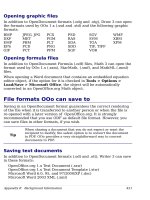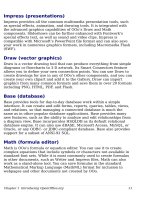Getting Started with Open Office .org 3 part 26 pptx
Bạn đang xem bản rút gọn của tài liệu. Xem và tải ngay bản đầy đủ của tài liệu tại đây (4.77 MB, 10 trang )
Figure 183: Example of Description entries
Creating tables for the list box
When the same information can be used in several fields, design a
table for each type of information. Each table will contain two fields:
the information field, and
ID
in this order.
Caution
You must create these tables with the information field listed
first and the and the ID field listed last. Failure to do so will
produce the wrong results. For my Payment table, I use
Name
and ID as my fields, with
Dan
,
Kevin
, and
Cash
being the Name
entries. The corresponding ID entries are
0, 1, 2
. When the
Name field is listed first in the table, one of the three names
will appear in the payment field of the Fuel table. If the ID field
is listed first,
0, 1,
or
2
appear in the payment field instead.
1) Follow the directions
in “Creating tables in Design View” on page
248. In the table we will create, the two fields can be
Type
and
PaymentID
. Make sure that the
AutoValue
is set to Yes for the
PaymentID
field. Set the
PaymentID
field as the primary key. (See
Figure 184.)
2) Save the table using the name
Payment Type
.
Chapter 8 Getting Started with Base 251
Figure 184: Table in Design View
Note:
If you have several tables to create with the same fields, design
one table and produce the other tables by cutting and pasting.
(See “Creating a table by copying an existing table” on page
247.)
Adding data to the list table
List tables do not require a form. Instead, add their data directly to the
table. In this example, use the names of the two people with a bank
card and Cash for cash purchases.
1) In the main database window, click on the
Tables
icon (Figure
176). Right-click on
Payment Type
and select Open from the
context menu.
a) Enter
Dan
in the first row. Use the tab key to move to the
second row.
b) Enter
Kevin
in the second row.
c) Enter
Cash
in the third row.
2) Save and close the table window.
Tip
The
Enter
key can also be used to move from field entry to field
entry. For this example, enter Jan. in the first
Name
field.
Enter
moves the cursor to the
ID
field.
Enter
then moves the cursor to
the second
Name
field.
The
Down Arrow
key can also be used to move from row to row.
Note
The
PaymentID
field contains
<AutoField>
until you use the
Enter
key to move to the second row. Then it becomes a 0. As
you add the entries to each row, the rows of the
PaymentID
field
change to consecutive whole numbers. For example the first
three numbers in this field are 0,1,2.
Creating a View
A View is a query. Because of this, the details of how to create and use
a View are in the Creating queries section.
252 Getting Started with OpenOffice.org 3
Figure 185: View of some fields from the Vacations table
A View is also a table. Its fields come from the fields of one or more
tables of the database. It provides a way to look at a number of fields
without regard to the table to which any of the fields belong. A View
can consists of some of the fields of one table as in Figure 185. Or, it
can consist of fields from more than one field as in Figure 186.
Figure 186: View of fields from the Fuel and Payment Type tables
Caution
Data can not be entered into a View like it can be added to a
table. It is strictly for viewing data which has already been
entered into the table.
Defining relationships
Now that the tables have been created, what are the relationships
between our tables? This is the time to define them based upon the
questions we asked and answered in the beginning.
When on vacation, we want to enter all of our expenses all at one time
each day. Most of these expenses are in the Vacations table, but the
fuel we buy is not. So, we will relate these two tables using the Date
fields. Since the Fuel table may have more than one entry per date,
this relationship between the Vacations and Fuel tables is one to many.
(It is designated 1:n.)
The Vacations tables also contains several fields for the type of
payment used. For each field listing the payment type, there is only
one entry from the Payment Type table. This is a one to one
relationship: one field in one table to one entry from the other table. (It
is designated 1:1.) Other tables also contain fields for the type of
payment. The relationship between these fields of those tables and the
Payment Type table are also 1:1.
Since the Payment Type table only provides a static list, we will not be
defining a relationship between the Payment Type table and the fields
Chapter 8 Getting Started with Base 253
of the other tables which use the entries of the Payment Type table.
That will be done when the forms are created.
The Fuel and Maintenance tables do not really have a relationship even
though they share similar fields: Date, and Odometer. Unless a person
is in a habit of regularly getting fuel and having their vehicle serviced,
the entries in these tables do not share anything in common.
Tip
As you create your own databases, you need to also
determine where tables are related and how.
1) We begin defining relationships by Tools > Relationships. The
Automobile – OpenOffice.org Base: Relation design window opens
(Figure 187). The icons we will use are Add Tables and New
Relation.
Figure 187: Relation design window
2) Click the Add Tables icon. The Add Tables window opens.
3) Use one of these ways to add a table to the Relation design
window:
• Double-click the name of the table. In our case, do this for
both Vacations and Fuel.
• Or, click the name of the table and then click Add for each
table.
4) Click Close when you have added the tables you want
(Figure 254).
Figure 188: Added table lists
5) Defining the relationship between the Vacations and Fuel tables.
Two ways exist to do this:
254 Getting Started with OpenOffice.org 3
New Relation icon
Add Tables
• Click and drag the
Date
field in the Fuel table to the
Date
field
in the Vacations table. When you release the mouse button, a
connecting line forms between the two date fields (Figure 189).
Figure 189: Designation for a 1:n relationship
• Or, click the New Relation icon. This opens the Relations
window (Figure 190). Our two tables are listed in the
Tables
involved
section.
– In the
Fields involved
section, click the dropdown list
under the Fuel label.
Figure 190: Setting the relationship
between tables
– Select
Date
from the Fuel table list.
– Click in the cell to the right of this dropdown list. This opens a
dropdown list for the Vacations table.
– Select
Date
from the Vacations table list. It should now look
like Figure 191.
– Click OK.
Figure 191: Selected fields in a relationship
6) Modifying the
Update options
and
Delete options
section of the
Relation window.
Chapter 8 Getting Started with Base 255
a) Right-click the line connecting the Date fields in the two table
lists to open a context menu.
b) Select Edit to open the Relation window (Figure 192).
c) Select Update cascade.
d) Select Delete cascade.
Figure 192: Update options and Delete options section
While these options are not absolutely necessary, they do help. Having
these options selected permits you to update a table that has a
relationship defined with another table. It also permits you to delete a
field from the table.
Creating a database form
Databases are used to store data. But, how is the data put into the
database? Forms are used to do this. In the language of databases, a
form is a front end for data entry and editing.
Figure 193: Fields of a simple
form
Figure 194: Simple Form with
additions
A simple form consists of the fields from a table (Figure 193). More
complex forms can contain much more. These can contain additional
text, graphics, selection boxes and many other elements. Figure 194 is
256 Getting Started with OpenOffice.org 3
made from the same table with a text label (Fuel Purchases), a list box
placed in PaymentType, and a graphic background.
Using the Wizard to create a form
We will use the Form Wizard to create two forms: CD Collection and
Vacations. The CD Collection form will be a simple form, while the
Vacations form will contain a form and a subform. We will create the
Vacations form with its subform and let you modify the CD Collection
form using the same process.
In the main database window (Figure 176), click the Form icon.
Double-click Use Wizard to Create Form to open the wizard (Figure
195). Simple forms require only some of these steps, while more
complex forms may use all of them.
Step 1: Select fields.
1) Under Tables or queries, select Vacations as the table.
Available
fields
lists the fields for the Vacations table.
2) Click the right double arrow to move all of these fields to the
Fields in the form
list. Click Next.
Figure 195: Form Wizard steps
Step 2: Set up a subform.
Since we have already created a relationship between the Fuel and
Vacations tables, we will use that relationship. If no relationship had
been defined, this would be done in step 4.
1) Click the box labeled
Add Subform
.
2) Click the radio button labeled
Subform based upon existing
relation
.
3) Fuel is listed as a relation we want to add. So, click Fuel to
highlight it, as in Figure 196. Click Next.
Chapter 8 Getting Started with Base 257
Figure 196: Adding a subform
Step 3: Add subform fields.
This step is exactly the same as step 1. The only difference is that not
all of the fields will be used in the subform.
1) Select Fuel under
Tables or queries
.
2) Use the >> button to move all the fields to the right.
3) Click the FuelID field to highlight it.
4) Use the < button to move the FuelID to the left (Figure 197).
5) Click Next.
Figure 197: Selecting fields of a subform
Step 4: Get joined fields.
This step is for tables or queries for which no relationship has been
defined. Since we want to list all expenses by the day they occur in
both the form and subform, we will joint the Date fields of these two
tables (Figure 198).
258 Getting Started with OpenOffice.org 3
Figure 198: Selection of joined subform and main form fields
1) Select Date from the
First joined subform field
dropdown list.
This is the Date field in the Fuel table. This is not the Primary key
for the Fuel table, but it is known as a Foreign key.
2) Select Date from the
First joined main form field
dropdown list.
This is the Date field in the Vacations table. This is the Primary
key for the Vacations table. Click Next.
Note
It is possible to create a relationship between two tables that is
based upon more than one pair of fields. How to do that and why
is discussed in the
Base Guide
.
Caution
When selecting a pair of fields from two tables to use as a
relationship, they have to have the same field type. That is why
we used the Date field from both tables: both their field types
are Date[DATE].
Whether a single pair of fields from two tables are chosen as
the relationship or two or more pairs are chosen, certain
requirements must be met for the form to work.
• No field from the subform can be the Primary key for its
table. (FuelID cannot be used.)
• Each pair of joined fields must have the same file type.
• One of the fields from the main form must be the Primary key
for its table. (Date would have to be used.)
Step 5: Arrange controls.
Note
Each control in a form consists of two parts: label and field. This
step in creating the form determines where a control's label and
field are placed in relationship with each other. The four choices
from left to right are
Columnar left
,
Columnar - Labels on top
, As
Data Sheet
, and
In Blocks - Labels Above
(Figure 199).
Chapter 8 Getting Started with Base 259
1) Arrangement of the main form: Click
Columnar - Labels on top.
The labels will be placed above their field.
2) Arrangement of the subform: Click
As Data Sheet
. (The labels are
column headings and the field entries are in spreadsheet format.)
Click Next.
Figure 199: Control arrangements
Step 6: Set data entry.
Unless you have a need for any of these entries to be checked, accept
the default settings. Click Next.
Step 7: Apply styles.
1) Select the color you want in the
Apply Styles
list. (I chose the
beige which is Orange 4 in the Color table.)
2) Select the Field border you want. (I prefer the 3-D look. You might
want to experiment with the different possible settings.)
3) Click Next.
Step 8: Set name.
1) Enter the name for the form. In this case, it is
Fuel
.
2) Click the circle in front of
Modify the form
. (This circle is called a
radio button.)
3) Click Next. The form opens in Edit mode.
260 Getting Started with OpenOffice.org 3









